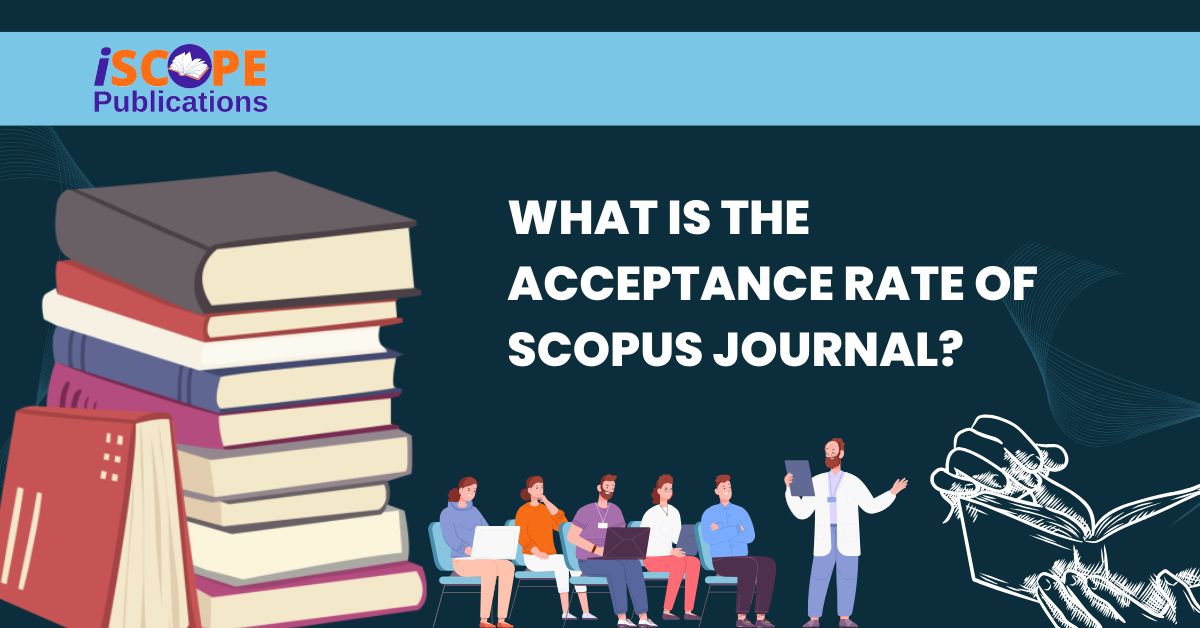Scopus journals are highly regarded in the academic community, offering a robust platform for researchers to share groundbreaking work in fields ranging from science and medicine to social sciences and humanities. Publishing in a Scopus indexed journal is no easy feat, as these journals uphold strict quality standards, impacting their acceptance rates. Acceptance rate of Scopus journals means, why it matters, and how authors can improve their chances of getting published.

Scopus Journals
What is Scopus?
Scopus is a comprehensive abstract and citation database curated by Elsevier. It encompasses peer-reviewed literature across a wide array of disciplines, offering coverage of over 25,000 journals. Journals must meet rigorous quality criteria to be indexed by Scopus, making it a trusted source for high-quality academic content.
Why Scopus Journals Are So Important?
Scopus journals carry a strong reputation because they are carefully selected based on strict criteria that evaluate the scientific quality and impact of their articles. Being indexed by Scopus not only signifies that the journal is reputable but also amplifies the visibility and credibility of the research published in it. This credibility factor is why many universities and funding agencies value publications in Scopus-indexed journals.
2. Defining Acceptance Rate and Why It Matters
What is Acceptance Rate?
In the context of academic publishing, the acceptance rate is the percentage of submitted papers that are accepted for publication in a journal. Lower acceptance rate typically signifies a more selective journal, which often correlates with higher prestige and impact within its field.
Why Researchers Care About Acceptance Rates?
For researchers, understanding the acceptance rate of a journal provides insight into the competition and selectivity of the publication. Journals with low acceptance rates are often seen as more prestigious, and having a paper accepted by such a journal can greatly enhance a researcher’s academic standing and career opportunities. Journal with a higher acceptance rate may be more approachable, making it a good option for researchers who are new to the publication process or are exploring less mainstream topics.
3. Factors Influencing the Acceptance Rate of Scopus Journals
Journal Quality Standards
Scopus journals are known for their high standards, and editors carefully screen submissions for relevance, originality, and impact. The acceptance rate varies widely depending on a journal’s subject area and quality standards.
Field-Specific Variations
Acceptance rates often differ across disciplines. For instance, journals in fields with rapid advancements, like computer science, may have higher acceptance rates compared to well-established fields like history or literature. Journals in emerging fields or those with more interdisciplinary focuses also tend to have varying acceptance rates.
Article Types
Journals may accept different types of submissions, such as original research, reviews, case studies, and opinion pieces. Review articles, which summarize existing knowledge, may have a different acceptance rate compared to original research papers due to different evaluation criteria.
Journal Impact Factor and Ranking
Many Scopus journals with high impact factors (IF) and high ranks in their respective fields are known for being highly selective. The higher a journal’s impact factor, the lower the acceptance rate tends to be, as such journals are sought after by top researchers aiming to share their work on influential platforms.
4. Estimated Acceptance Rates in Scopus Journals
Typical Range of Acceptance Rates
While the exact acceptance rates of Scopus journals vary widely and are rarely disclosed by publishers, there are some general patterns:
- Top-Tier Journals: Acceptance rates can range from 5% to 20%, particularly in highly competitive fields like medicine, engineering, and environmental science.
- Mid-Tier Journals: Journals may have acceptance rates from 20% to 40%, offering a balanced approach to selectivity and accessibility.
- Broad-Interest or Regional Journals: Acceptance rates in these journals could be higher, often between 40% and 70%, making them more accessible to early-career researchers or those focusing on specific geographic areas.
5. How to Improve Your Chances of Acceptance in a Scopus Journal?
Select the Right Journal
Choosing a journal that aligns well with your research topic and methodology is crucial. Scopus provides detailed descriptions and scopes for each journal, helping authors find a journal that fits their research well.
Follow Submission Guidelines Carefully
Every journal has specific submission guidelines regarding formatting, referencing style, and word count. Strict adherence to these guidelines demonstrates professionalism and increases your chances of passing initial editorial review.
Write a Strong Abstract
Abstract is often the first thing an editor or reviewer will read. Make sure it’s concise, clearly presenting your research question, methods, results, and implications. A compelling abstract can capture interest and encourage further reading.
Emphasize Novelty and Contribution
Scopus journals look for research that brings new insights or advancements to a field. Highlight the unique aspects of your research and its potential impact on the field. Clearly articulating your contribution can significantly enhance your manuscript’s appeal.
Seek Feedback Before Submission
Sharing your work with colleagues, mentors, or other experts in the field before submission can help identify any weaknesses or gaps. Constructive feedback can strengthen your paper and boost your confidence during the peer review process.
Address Reviewer Comments Carefully
If you receive a “revise and resubmit” response, carefully consider each comment from the reviewers and address them in detail. Even if some comments seem minor, addressing them thoroughly shows respect for the reviewer’s time and effort.
6. Peer Review Process: What to Expect
Initial Editorial Screening
Before a manuscript is sent for peer review, it undergoes an initial screening by the journal’s editorial team. During this phase, editors assess whether the submission aligns with the journal’s scope and meets basic quality standards.
Peer Review and Decision
If the paper passes the editorial screening, it moves to the peer review stage, where experts in the field evaluate it. Process can be single-blind, double-blind, or open, depending on the journal’s policies. Peer review is a thorough and time-consuming process, during which reviewers scrutinize the methodology, data analysis, and conclusions.
Revisions and Acceptance
Review process often involves multiple rounds of revision, particularly in high-quality journals. Only after the reviewers are satisfied with the changes will the paper be accepted. Paper may be rejected after one or more rounds of review if the authors are unable to meet the standards required by the reviewers.
7. Challenges of Publishing in Low-Acceptance Rate Journals
Intense Competition
Due to high prestige and rigorous standards, acceptance rates in many Scopus journals remain low. This intense competition can be challenging, especially for early-career researchers who are just starting to build their publication record.
High Expectations from Reviewers
Reviewers for Scopus journals often have high expectations regarding the novelty, methodological rigor, and significance of research. Authors should be prepared for detailed feedback that may require substantial revisions.
Balancing Quality and Accessibility
Researchers must strike a balance between aiming for top-tier journals with low acceptance rates and journals with higher acceptance rates that are still reputable. Finding the right balance is essential to ensure the work reaches the right audience without compromising on visibility or impact.
8. Choosing the Right Journal for Work
Acceptance rate of a journal is only one factor to consider when choosing where to submit your work. While publishing in a high-impact, low-acceptance-rate journal is a prestigious achievement, many reputable journals with higher acceptance rates can still offer significant exposure and credibility. Researchers should weigh factors such as journal reputation, audience, relevance, and personal career goals when selecting a Scopus journal.
Acceptance rate of Scopus journals reflects the quality and selectivity of these respected publications. Rate, alongside other factors like the journal’s scope, impact factor, and peer review process, can help researchers make informed choices when submitting their work. By choosing an appropriate journal, following best practices, and focusing on quality, authors can increase their chances of publication success in a Scopus-indexed journal, advancing their careers and contributing valuable knowledge to their fields.



